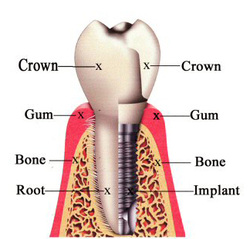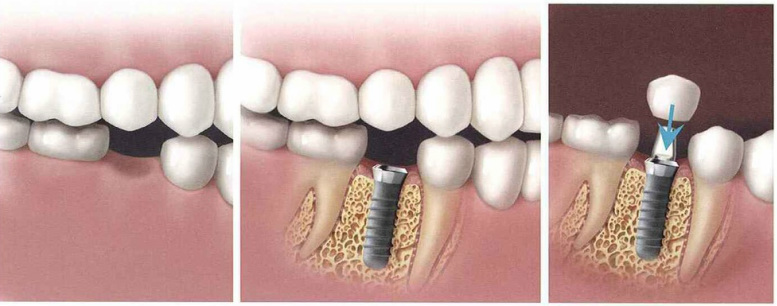Dental Implants

What are Dental Implants? Dental Implants have been used successfully for many years. The implant itself is a post that is surgically placed in the jaw. A prosthesis (artificial tooth or teeth) is then attached to the post.
Dental Implants have been used successfully for many years. The implant itself is a post that is surgically placed in the jaw. A prosthesis (artificial tooth or teeth) is then attached to the post.
Dental implants are often the best treatment for missing teeth. When a damaged or decayed tooth is removed, both the visible part of the tooth, called the crown, and the root are lost.
A dental implant is placed in the jawbone so that it can fuse with your natural bone and become a strong and sturdy foundation for replacement teeth. Implants can be used to replace an individual tooth or for an implant-supported bridge or denture containing multiple teeth.
Dental implants are the closest you can get to healthy, natural teeth. They will allow you to confidently eat, smile, laugh, talk, play and enjoy all of your regular activities of everyday life without thinking about your teeth.
Dental Implants have been used successfully for many years. The implant itself is a post that is surgically placed in the jaw. A prosthesis (artificial tooth or teeth) is then attached to the post. Dental implants involve cooperation between a specialist and our office. The surgical phase of treatment is completed by the specialist, and the restorative phase is completed at our office.
What are Dental Implants used for?
There are two basic uses for Dental Implants:
What are the benefits of Dental Implants?
Dental Implants have been used successfully for many years. The implant itself is a post that is surgically placed in the jaw. A prosthesis (artificial tooth or teeth) is then attached to the post.
Dental implants are often the best treatment for missing teeth. When a damaged or decayed tooth is removed, both the visible part of the tooth, called the crown, and the root are lost.
A dental implant is placed in the jawbone so that it can fuse with your natural bone and become a strong and sturdy foundation for replacement teeth. Implants can be used to replace an individual tooth or for an implant-supported bridge or denture containing multiple teeth.
Dental implants are the closest you can get to healthy, natural teeth. They will allow you to confidently eat, smile, laugh, talk, play and enjoy all of your regular activities of everyday life without thinking about your teeth.
Dental Implants have been used successfully for many years. The implant itself is a post that is surgically placed in the jaw. A prosthesis (artificial tooth or teeth) is then attached to the post. Dental implants involve cooperation between a specialist and our office. The surgical phase of treatment is completed by the specialist, and the restorative phase is completed at our office.
What are Dental Implants used for?
There are two basic uses for Dental Implants:
- As an artificial root for a single tooth replacement.
- As anchors for a fixed or removable prosthesis to replace multiple teeth
What are the benefits of Dental Implants?
- Next best thing to healthy, natural teeth. Strong and stable, a dental implant restores a lost tooth so that it looks, feels, fits and functions like a natural tooth. Other options can lead to bone deterioration, and may interfere with eating, smiling, speaking and other activities of everyday life.
- Built to last. Dental implants are a long-term solution. Traditional, tooth-supported dental bridges only last five to seven years, and with proper care often more than 10 years, but at some point they may need to be replaced. While dental implants may need periodic adjustments, they can last a lifetime when properly placed and cared for over time.
- Enjoy life without worrying about your teeth! No need to stay home or feel uncomfortable in public, embarrassed because your smile looks different, or worrying that missing teeth will limit your ability to join in the fun or that removable dentures or tooth-supported replacement teeth will loosen or fall out when you talk, eat or laugh. Teeth restored with dental implants are teeth that let you, not your teeth, lead your life.
- Retain your natural face shape, and smile. A face without teeth can sag and appear sunken and sad. Dental implants allow you to maintain the natural shape of your face and smile.
- Protect healthy bone. Leaving empty spaces in your mouth after losing one or more teeth can lead to additional health issues, such as the loss and deterioration of some of your jawbone. When it is not being used to support a natural tooth, the jawbone deteriorates, losing its strength and firmness. Dental implants are the only dental restoration option that preserves and stimulates natural bone, actually helping to stimulate bone growth and prevent bone loss.
- Keep your teeth in your mouth – not in a cup. Dental implants allow you to keep your teeth where they belong – in your mouth. And no more worrying that your dentures might slip or fall out. Brush, floss and care for teeth that have been replaced using dental implants exactly the way you would natural teeth – in your mouth.
- Speak easy. Adjusting to removable dentures can mean struggling to pronounce everyday words. Not so with dental implants, which function like natural teeth.
- Eat your favorite foods! Taste and enjoy the foods you love without hesitation. You can bite naturally, eat virtually anything you want and, unlike removable dentures that can feel uncomfortable, you can experience the full taste of the food you eat with dental implants, too.
- Look Mom, no cavities! Cavities can’t occur in an implant-restored crown, or replacement tooth; however, you will need to visit your dentist as scheduled and clean and care for it and your gums and mouth every day, the same as you would if it were a natural tooth.
- Keep teeth in place – silently. Dentures may slip when you eat, talk, smile, laugh, kiss, yawn or cough, so that you have to “reposition” them back into place in the mouth. Dental implants are fixed in place and fuse naturally with your jawbone, meaning your replacement teeth won’t move, click or shift.
- Protect your healthy teeth. Placing a tooth-supported bridge requires grinding away the teeth on one or both sides of the missing tooth or teeth – thereby damaging healthy teeth to restore those that are missing. The modified healthy teeth are attached to, and support, the bridge. Dental implants go in the jawbone, in the spot where your missing tooth root was, without impacting healthy teeth. They also help prevent healthy, adjacent teeth from shifting as they would if an empty space were left for an extended period of time.
Dental Implant Stages
Stage I
This is the surgical stage in the placement of a dental implant. The implant is placed and in the jaw and allowed to heal and integrate with the surrounding bone. The time it takes for a dental implant to integrate with the surrounding jaw bone (alveolar bone) varies from patient to patient. Some of the main factors that can affect healing include the location of placement, health of the individual, quality of bone (good blood supply, soft malleable bone vs. poor blood supply, rigid bone), health of the surrounding area where implant is placed, type of dental implant used, and oral hygiene of the implant recipient. All these factors can determine how fast and how well the dental implants will integrate. After a dental implant is placed it can take anywhere from 3 to 6 months before the final restoration is completed. Healing time will vary from 3-4 months in the lower jaw to 4-6 months in the upper jaw. Implant placement surgery is completed with just local anesthesia and the whole procedure is performed under sterile conditions.
Stage II
The top of the Implant is uncovered and a small healing cap is attached.
Stage III
At this appointment an impression for a crown is obtained. The dentist will attach an impression piece to the implant and obtain a dental impression for the crown or a bridge.
Stage IV
This appointment is to fit the crown or bridge.
This is the surgical stage in the placement of a dental implant. The implant is placed and in the jaw and allowed to heal and integrate with the surrounding bone. The time it takes for a dental implant to integrate with the surrounding jaw bone (alveolar bone) varies from patient to patient. Some of the main factors that can affect healing include the location of placement, health of the individual, quality of bone (good blood supply, soft malleable bone vs. poor blood supply, rigid bone), health of the surrounding area where implant is placed, type of dental implant used, and oral hygiene of the implant recipient. All these factors can determine how fast and how well the dental implants will integrate. After a dental implant is placed it can take anywhere from 3 to 6 months before the final restoration is completed. Healing time will vary from 3-4 months in the lower jaw to 4-6 months in the upper jaw. Implant placement surgery is completed with just local anesthesia and the whole procedure is performed under sterile conditions.
Stage II
The top of the Implant is uncovered and a small healing cap is attached.
Stage III
At this appointment an impression for a crown is obtained. The dentist will attach an impression piece to the implant and obtain a dental impression for the crown or a bridge.
Stage IV
This appointment is to fit the crown or bridge.

